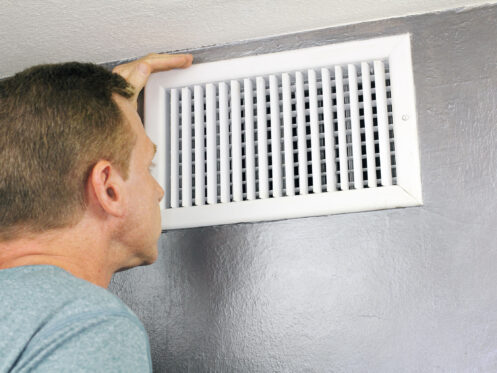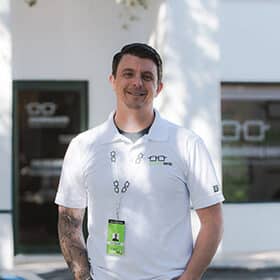Microbial growth in a home is a serious health concern. It can impact air quality and have a wide range of adverse short-term health effects, including disrupting sleep. Long-term exposure can lead to even more serious health conditions. There are many potential sources of microbial growth in the home, but perhaps the most notable is your air conditioner. Let’s explore what you can do to prevent microbial growth and how to address it if it’s present.
Identifying Microbial Growth in Your AC System
It’s important to note that microbial growth can be present and affecting your health long before you can see or smell it. It can even be present in your air in the form of fungal spores. This is why it’s so important to take preventative measures. If you notice a musty smell when your AC cycles on, that’s a clear sign you may have microbial growth. You should also schedule an annual indoor air quality test. IAQ testing can reveal microbial growth and many other issues.
Schedule Spring AC Maintenance
All AC systems require annual maintenance, and we advise scheduling your AC tune-up in the spring before needing to run your air. There are many reasons routine maintenance is a good idea, including reduced cooling costs and avoiding repairs. Another is microbial growth. All AC systems have an evaporator coil that’s integral to the refrigeration process. Warm air passes over the coil, and the heat transfers to the refrigerant contained within.
That process creates condensation, which sets the stage for microbial growth. During maintenance, your technician will use coil cleaner to remove all growth and grime from the coil. It’s also important to clean the drip pan and drain line, as growth can occur in those areas as well.
Book an AC Checkup After Summer
When the summer draws to a close and you’re no longer using your AC, schedule maintenance again. Your technician will check the overall health of the system and determine if there’s microbial growth. If there is growth, you can explore solutions beyond just cleaning. That can include adding microbial growth inhibitors or installing additional equipment.
Moisture Control in the Home
Microbial growth can occur in your AC system simply due to the condensation created. That said, excess moisture in the home from other sources can make your AC more prone to growth. Take care when tending to houseplants, for instance. Overwatering them can cause fungal spores to form and eventually float into the air, and they can potentially reach your AC and flourish there.
Summers in our service areas are naturally humid. There can be excess moisture in your home through no fault of your own. It can reduce energy efficiency, increase wear and tear on the system, and set the stage for growth. The Environmental Protection Agency warns against letting relative humidity get above 60%. If you can’t maintain 60% or lower through cooling alone, consider adding a whole-house dehumidifier. It will extract moisture from your air to bring the RH down to a healthy and comfortable level.
Good AC Filter Habits
Maintaining a clean AC between maintenance appointments can help to avoid microbial growth. All ACs have a filter that’s designed to keep contaminants out of the system. Use a high-quality filter that you won’t have to swap out as often. Consider its minimum efficiency reporting value as well. The HVAC industry uses the MERV rating to measure filter efficiency. Most modern systems can support at least MERV 8, and many can support up to MERV 13.
Check your filter at least once a month, and replace it as needed (generally every 60-90 days). When it’s time to replace it, you’ll either see dust caked on the outer surface or hear a whistling sound. (The whistling sound means air is going around the frame instead of through it.) In most cases, you’ll need to discard the filter; only change it if you have one specifically labeled for reuse.
Standard pleated filters should never get wet either. If you have a filter that’s accumulating moisture, discard it immediately. If you use a reusable filter, be sure it’s entirely dry before putting it back in the system.
Ductless ACs often have reusable filters as well. You should check those at least every two weeks and clean them as needed. You should also replace them in the spring. Your technician can do that for you during your seasonal AC maintenance.
Ductwork Inspections and Maintenance
Microbial growth can occur in your ducts too. It may be the cause of the mustiness you smell rather than your evaporator coil. Growth on the coil can make it into the ducts. Dust will accumulate in your ducts over time as well. While dust doesn’t usually result in microbial growth, it can if moisture also gets into the ducts.
The industry recommendation is to schedule a camera inspection of your ducts at least every other year. Routine AC maintenance doesn’t include a duct inspection, but you can schedule the services for the same appointment. During the inspection, your technician will use a high-definition camera to identify any problems in the ducts.
A common issue with ducts as they get older is air leakage. The Department of Energy estimates average cooling losses between 20% and 40%. Air leakage can also negatively affect indoor air quality and allow microbial growth into the system. Leakage can happen because the seals between duct sections wear out over time. Duct sealing is an effective solution to that problem. Other potential duct repairs include replacing mounting hardware and using mastic sealant for large punctures.
If there’s significant accumulation in your ducts, the industry recommends duct cleaning. This is where a technician uses an industrial vacuum to remove all the dust and other debris. If there’s microbial growth, it will remove that as well. If there’s a moisture problem, you’ll need to remediate it. Once that’s completed, your technician can then sanitize the ducts for health purposes and to keep the growth gone.
Install Air Purification
You may also want to consider one or more air purification solutions. Your HVAC filter provides some filtration, but the air pressure needs of the system limit it. For additional filtration, consider an air purifier with a high-MERV or HEPA filter. It will extract much of the airborne microbial growth that passes through the ducts. You may want to install an ultraviolet lamp as well. UV lamps emit light that neutralizes microbial growth, along with germs, viruses, and other pathogens.
Keep Your Southwest Florida AC System in Pristine Condition
Plumbing, Cooling & Electrical Nerds is an award-winning business that provides heating and cooling services throughout Southwest Florida. Our company has locations in Bonita Springs, Cape Coral, Fort Myers, and Naples. Our technicians perform cooling maintenance in the spring and after-summer checkups. We install and repair air conditioners, heat pumps, ductless mini-splits, and electric and gas furnaces. Our team performs home energy audits that help our customers improve comfort and efficiency. We install, repair, and clean ductwork and perform air quality testing.
You can also count on us for thermostats, whole-house fans, dehumidifiers, air purifiers, and germicidal lights. Our plumbers specialize in sewer lines, septic systems, wells, water heaters, bathroom and kitchen fixtures, and water treatment. We even provide free water quality testing. Call today or contact us online to schedule your free test.

